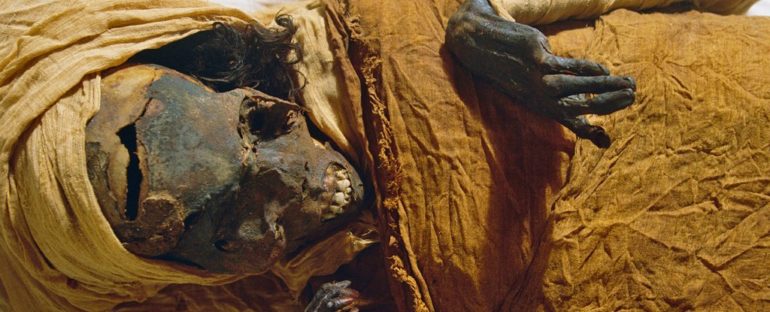While we can learn a lot about mummification from ancient examples of the practice, questions remain about exactly how the Egyptians prepared their dead for the afterlife.
In an exciting discovery, researchers have discovered an original ‘how to’ manual, hidden inside an ancient text, which explains the crucial steps to embalming and creating a mummy.
The guide to mummification has been found on a 3,500-year-old piece of papyrus called the Papyrus Louvre-Carlsberg manuscript, so called because half of it, primarily containing medical information, is in the Louvre Museum in Paris and the other half is part of the Papyrus Carlsberg Collection at the University of Copenhagen in Denmark.
Before this new text came to light, experts only had two original texts on mummification to work with. The process was considered a sacred art in ancient Egypt, with only a few specialists instructed in the ways of embalming, and the knowledge usually passed on verbally from person to person.
The face covering process revealed in the new research. (Ida Christensen)
“The text reads like a memory aid, so the intended readers must have been specialists who needed to be reminded of these details, such as unguent recipes and uses of various types of bandages,” says Egyptologist Sofie Schiødt, from the University of Copenhagen.
Schiødt has published details about the text in her PhD thesis, and the full Louvre papyrus will be published next year.

Among the details that Schiødt has teased out of the document is a list of instructions for embalming the face of the deceased person, which was done with a piece of red linen coated in a special plant-based solution.
The solution included aromatic substances as well as binders for holding the mixture together, and the saturated cloth was intended to keep the face protected from insects and bacteria while also smelling sweet. This process hasn’t been documented before, but does match up with some of the mummified remains that have been found.
This manuscript also lays out the full 70-day schedule for embalming, split into two halves: a 35-day drying period and a 35-day wrapping period, which were themselves divided into four-day intervals. Common treatments to the body included applying a mixture called natron, after the removal of the organs and the brain. Although the use of natron wasn’t mentioned in this specific text, Schiødt explains.
“A ritual procession of the mummy marked these days, celebrating the progress of restoring the deceased’s corporeal integrity, amounting to 17 processions over the course of the embalming period,” says Schiødt.
“In between the four-day intervals, the body was covered with cloth and overlaid with straw infused with aromatics to keep away insects and scavengers.”
This is the first time the Carlsberg Collection half of the manuscript has been analysed and translated, and it adds to the information already interpreted from the Louvre Museum half, covering information about herbal medicine and skin swellings.
Around six metres (nearly 20 feet) in length, the papyrus is now an even more important source on disease and health in ancient Egypt – including which ailments were thought to be the work of which gods, and how they could be combated.
The Papyrus Louvre-Carlsberg manuscript is older than the two mummification manuals that have previously been discovered, and so becomes the oldest record of the practice that we now have. It also includes details lacking in the other two documents.
“Many descriptions of embalming techniques that we find in this papyrus have been left out of the two later manuals, and the descriptions are extremely detailed,” says Schiødt.
The research hasn’t been published in a peer-reviewed journal but it forms the basis of the PhD thesis being written by Schiødt.
